
A papal conclave is a gathering of the College of Cardinals convened to elect a bishop of Rome, also known as the pope. Catholics consider the pope to be the apostolic successor of Saint Peter and the earthly head of the Catholic Church.
The history of the Catholic Church is integral to the history of Christianity as a whole. It is also, according to church historian Mark A. Noll, the "world's oldest continuously functioning international institution." This article covers a period of just under two thousand years.

Catholic Mariology is Mariology in Catholic theology. According to the Immaculate Conception taught by the Catholic Church, she was conceived and born without sin, hence Mary is seen as having a singular dignity above the saints, receiving a higher level of veneration than all angelic spirits and blessed souls in heaven. Catholic Mariology thus studies not only her life but also the veneration of her in daily life, prayer, hymns, art, music, and architecture in modern and ancient Christianity throughout the ages.
Romano Pontifici eligendo was the apostolic constitution governing the election of popes that was promulgated by Pope Paul VI on 1 October 1975. It instituted a number of far-reaching reforms in the process of electing popes. It set the maximum number of electors at 120 and restated in a more formal context the rule he had already instituted that cardinals over the age of 80 not participate in electing a pope.
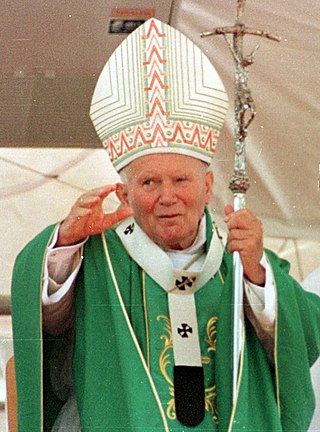
The teachings of Pope John Paul II are contained in a number of documents. It has been said that these teachings will have a long-lasting influence on the Church.

The Saint John Paul II National Shrine is a national shrine in Washington, D.C., sponsored by the Knights of Columbus. It is a place of prayer for Catholics and welcomes people of all faiths. The Shrine houses a permanent exhibit called A Gift of Love: the Life of Saint John Paul II and is home to the Redemptor Hominis Church and Luminous Mysteries Chapel, both of which are decorated with mosaic art designed by Rev. Marko Rupnik, S.J. Mass is celebrated daily in the Redemptor Hominis Church, and the Luminous Mysteries Chapel houses a first-class relic of John Paul II.
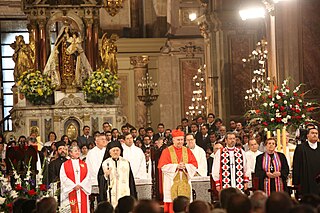
The Catholic Church has engaged in the modern ecumenical movement especially since the Second Vatican Council (1962-1965) and the issuing of the decree Unitatis redintegratio and the declaration Dignitatis humanae. It was at the Council that the Pontifical Council for Promoting Christian Unity was created. Those outside of the Catholic Church were categorised as heretics or schismatics, but in many contexts today, to avoid offence, the euphemism "separated brethren" is used.
Branch theory is an ecclesiological proposition that the One, Holy, Catholic, and Apostolic Church includes various different Christian denominations whether in formal communion or not. The theory is often incorporated in the Protestant notion of an invisible Christian Church structure binding them together.
Maximos IV Sayegh was Patriarch of Antioch and All the East, and Alexandria and Jerusalem of the Melkite Greek Catholic Church from 1947 until his death in 1967. One of the fathers of Second Vatican Council, the outspoken patriarch stirred the Council by urging reconciliation between the Catholic and Eastern Orthodox churches. He accepted the title of cardinal in 1965 after Pope Paul VI clarified the significance of that title in the case of an Eastern Patriarch.

Redemptoris Mater is an encyclical by Pope John Paul II delivered on March 25, 1987 in Saint Peter's Basilica in Rome. Subtitled On the Blessed Virgin Mary in the life of the Pilgrim Church, the text addresses a number of topics in Mariology.

The history of Catholic Mariology traces theological developments and views regarding Mary from the early Church to the 21st century. Mariology is a mainly Catholic ecclesiological study within theology, which centers on the relation of Mary, the Mother of God, and the Church. Theologically, it not only deals with her life but with her veneration in life and prayer, in art, music, and architecture, from ancient Christianity to modern times.

The Mariology of the popes is the theological study of the influence that the popes have had on the development, formulation and transformation of the Roman Catholic Church's doctrines and devotions relating to the Blessed Virgin Mary.
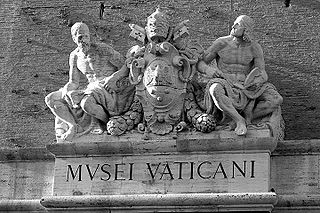
The Collection of Modern and Contemporary Art is a collection of paintings, graphic art and sculptures in the Vatican Museums.
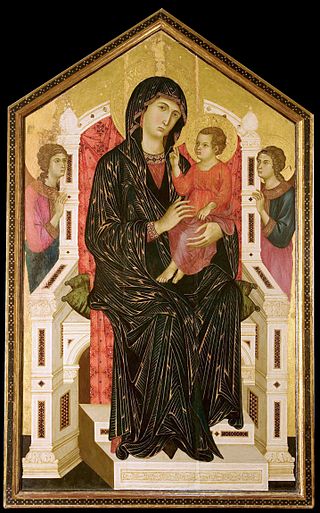
Mariological papal documents have been a major force that has shaped Roman Catholic Mariology over the centuries. Mariology is developed by theologians on the basis not only of Scripture and Tradition but also of the sensus fidei of the faithful as a whole, "from the bishops to the last of the faithful", and papal documents have recorded those developments, defining Marian dogmas, spreading doctrines and encouraging devotions within the Catholic Church.
Mother of the Church is a title given to Mary in the Catholic Church, as officially declared by Pope Paul VI in 1964. The title first appeared in the 4th century writings of Saint Ambrose of Milan, as rediscovered by Hugo Rahner. It was also used by Pope Benedict XIV in 1748 and then by Pope Leo XIII in 1885. Pope John Paul II placed it in the Catechism of the Catholic Church and Pope Francis inserted a feast by this title into the Roman Calendar.
This is an index of Vatican City–related topics.

The Church of Saint Alphonus of Liguori is a rectory church located on the Via Merulana on the Esquiline Hill of central Rome's Vth prefecture, Italy, and a titular church for a Cardinal-priest under the name Santissimo Redentore e Sant'Alfonso in Via Merulana.

Redemptoris Custos is the title of an apostolic exhortation by Pope John Paul II on Saint Joseph. It was delivered on August 15, 1989 in Saint Peter's Basilica in Rome on the occasion of the centenary of Pope Leo XIII's encyclical Quamquam pluries.
The new evangelization is the particular process by which baptized members of the Catholic Church express the general Christian call to evangelization.
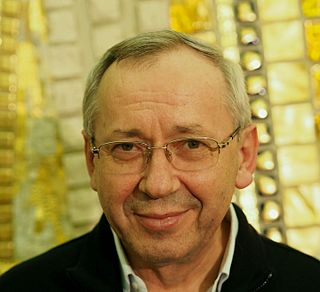
Marko Ivan Rupnik is a Slovenian priest, theologian, mosaic artist, and former Jesuit. Among the churches he has decorated around the world are the Saint John Paul II National Shrine in Washington D.C., the Redemptoris Mater Chapel in the Vatican's Apostolic Palace, the Sanctuary of Our Lady of Lourdes, the Sanctuary of Fátima, the Sanctuary of Saint Pio of Pietrelcina, the Almudena Cathedral in Madrid. He was the director of Centro Aletti in Rome and he was a theological student of Tomáš Špidlík.












